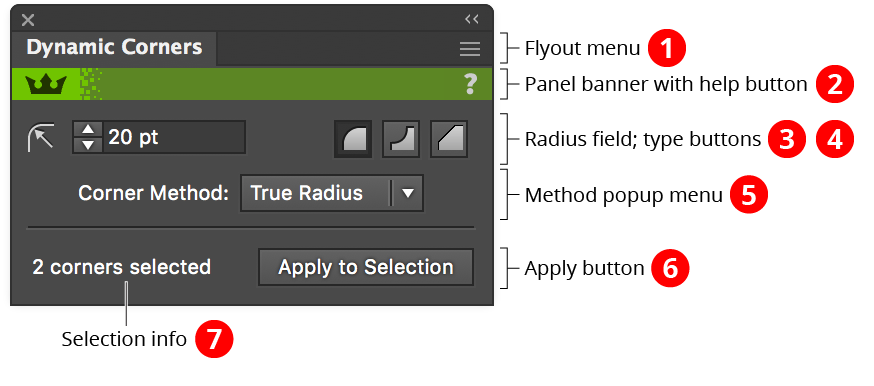 Dynamic Corners Panel
Dynamic Corners Panel
The Dynamic Corners panel is used in conjunction with the tool to change existing corners, to set the parameters that will be used for new corners, and to access several utility functions. When the Dynamic Corners tool is not in use, the panel displays only a “Click to select” message; clicking anywhere on the panel selects the tool and displays all the controls.

Dynamic Corners panel
1. Flyout menu
See Dynamic Corners Panel: Flyout Menu.
2. Panel banner
The help button on the right opens the help documentation in the Astute Manager. If this does not automatically appear, please ensure your Astute Manager is running first.
Click on the other area of the color bar to activate the Dynamic Corners tool. This is a quick method of locating the tool within the default Advanced toolbar or a custom toolbar.
3. Radius field
Specifies the radius of all selected corners, or for new corners created by clicking without dragging. If a corner cannot accommodate the specified radius, the radius will be made as large as possible.
Shift-clicking on the radius icon is a shortcut for choosing the flyout menu item Select All Corners on Selected Paths. Shift+Option/Alt-clicking on the radius icon is a shortcut for choosing the flyout menu item Convert to Dynamic Corners.
4. Type Buttons
Specifies the type of all selected corners, or for new corners created by clicking without dragging.
5. Method Popup Menu
Specifies the method of all selected corners, or for new corners created by clicking without dragging.
6. Apply Button
Applies corners (using the settings showing in the panel) to all eligible selected anchor points.
7. Selection Info
Displays the current number of selected Dynamic Corners.
Dynamic Corners Panel Flyout Menu

Dynamic Corners panel flyout
1. Convert to Dynamic Corners
2. Convert to Dynamic Corners (Strict)
These menu items convert all Regular-type, non-dynamic corners (such as those created using Adobe’s native Live Corners) on selected paths to Dynamic Corners, when possible. If no paths are selected, all unlocked and unhidden paths in the document are considered. The “Strict” version differs in that the corner geometry must be closer to “ideal” for conversion to occur than the non-Strict version, which uses a higher tolerance. Negative corners may be detected as Regular corners facing in the opposite direction. The Dynamic Corners tool will automatically be selected afterwards if it is not already, so you can work with the new corners.
3. Convert Round Corner Effects
Converts corners on selected paths which have the native Round Corners live effect applied. If no paths are selected, all unlocked and unhidden paths in the document are considered.
4. Remove Selected Corners
Removes selected Dynamic Corners, which is equivalent to setting their radius value to zero.
5. Remove Dynamic Status (Selected)
6. Remove Dynamic Status (All In Document)
Converts all the Dynamic Corners on selected paths, or on all paths in the document, to non-Dynamic. This is recommended in a few situations, such as on artwork that is being used inside a pattern or a symbol.
7. Select Similar-Radius Corners on Selected Paths
Selects all Dynamic Corners on selected paths which have a radius that is within a tolerance of the radius of the selected corner. The tolerance value can be specified in the preferences. If no paths are selected, all similar corners in the document will be selected.
8. Select All Corners on Selected Paths
Selects all Dynamic Corners on selected paths. If no paths are selected, all corners in the document will be selected.
9. Active Dynamic Corner Mode
When moving an anchor point that is adjacent to a Dynamic Corner, it is best to use the Dynamic Corners tool, as it allows you to see in real-time how the adjacent corner is being affected (see Dynamic Corners Tool: Editing Existing Corners). However, when this preference is enabled (the default; indicated by a checkmark), Dynamic Corners will still monitor changes to paths which have Dynamic Corners, and, when the tool is reselected, will recalculate the corners based on the new locations of the anchor points.

Dynamic Corners active mode example
10. Dynamic Corners Preferences...
Brings up the Preferences dialog (see Dynamic Corners Preferences).
